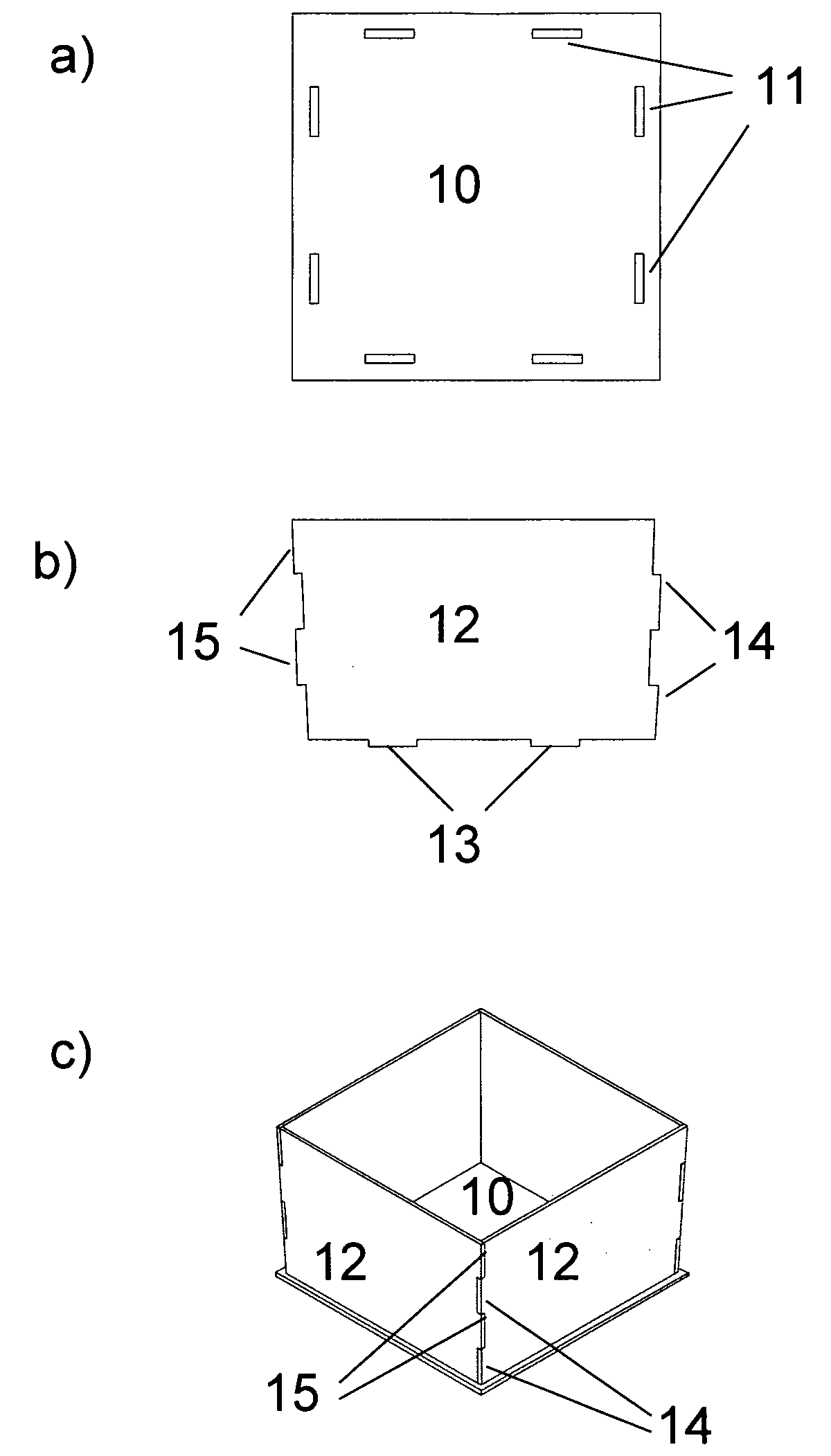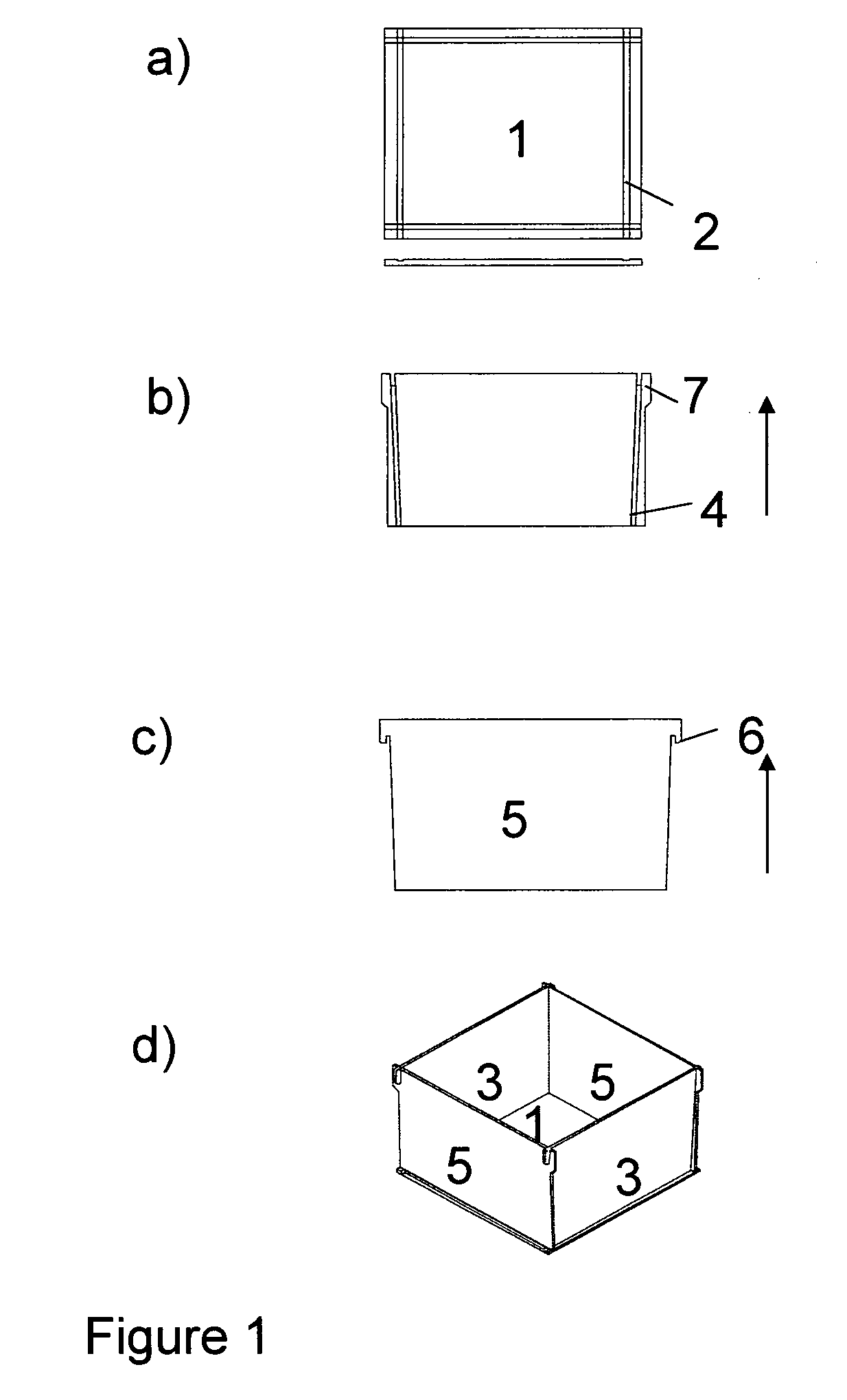Method and crucible for direct solidification of semiconductor grade multi-crystalline silicon ingots
a technology of multi-crystalline silicon and crucible, which is applied in the direction of crystallization separation, inorganic chemistry, crystal growth process, etc., can solve the problems of low possibility of controlling heat flux, limited heat removal rate, and hampered lateral direction, so as to increase the crystallization rate and stress in the crystalline silicon. , the effect of increasing the thermal gradien
- Summary
- Abstract
- Description
- Claims
- Application Information
AI Technical Summary
Benefits of technology
Problems solved by technology
Method used
Image
Examples
example 1
[0047]The crucible according to example 1 is schematically illustrated in FIG. 1a to 1d.
[0048]FIG. 1a illustrates the bottom plate 1, which is a quadratic plate with a groove 2 on the upward facing surface along each of its sides. The grove is fitted to the thickness of the side elements forming the walls of the crucible such that the lower edge of the side walls enters into the groove and forms a tight fitting. Alternatively, the side elements and the bottom groove may be given a complementary shape such as e.g. a plough and tongue.
[0049]FIG. 1b shows one rectangular wall element 3. There will be used two of these at opposing sides, see FIG. 1d. The side element 3 is equipped with a groove 4 along both edges on the surface facing inwards into the crucible. The grooves 4 are dimensioned to give a tight fitting with the side edges of the wall elements 5 placed perpendicularly on the wall elements 3. The grooves 4 and side edges of the wall elements 3 may be given an congruent angled...
example 2
[0052]The crucible according to example 2 is schematically illustrated in FIG. 2a to 2c.
[0053]FIG. 2a illustrates the bottom plate 10, which is a quadratic plate with two elongated apertures 11 along each of its sides. The dimensions of the apertures are fitted such that they can receive a downward facing protrusion of the side walls and form a tight fitting. It is also envisioned to include grooves (not shown) running aligned with the centre axis of the apertures 11, similar to the grooves 2 of the bottom plate 1 of the first example.
[0054]FIG. 2b shows one wall element 12. There will be four of these elements, see FIG. 2c. The side element 12 is equipped with two protrusions 14, 15 on each side and two downward protrusions 13. The side protrusions are dimensioned such that the protrusion 14 enters the space between the protrusions 15 and forms a tight fitting when two wall elements 12 are assembled forming adjacent walls of the crucible. The downward facing protrusions 13 are dim...
example 3
Calculated Temperature Profile in a Furnace with Use of a Prior Art Silica Crucible
[0057]A calculation of a steady state one-dimensional temperature gradient at the start of crystallization with a standard furnace process is shown in FIG. 3. The temperature at the inside of the crucible bottom is 1415° C. The crucible bottom is 2 cm thick, and its thermal conductivity is 1.5 W / mK. The support plate is 60 mm thick, and its thermal conductivity is 80 W / mK. In order to remove 10 kW / m2, the temperature at the bottom of the support plate must be lowered to 1398° C. This rate of heat transfer can give crystallization rates up to 0.9 cm / h, depending on the amount of heat transported from the top chamber.
PUM
| Property | Measurement | Unit |
|---|---|---|
| Thickness | aaaaa | aaaaa |
| Thermal resistance | aaaaa | aaaaa |
| Heat | aaaaa | aaaaa |
Abstract
Description
Claims
Application Information
 Login to View More
Login to View More - R&D
- Intellectual Property
- Life Sciences
- Materials
- Tech Scout
- Unparalleled Data Quality
- Higher Quality Content
- 60% Fewer Hallucinations
Browse by: Latest US Patents, China's latest patents, Technical Efficacy Thesaurus, Application Domain, Technology Topic, Popular Technical Reports.
© 2025 PatSnap. All rights reserved.Legal|Privacy policy|Modern Slavery Act Transparency Statement|Sitemap|About US| Contact US: help@patsnap.com



